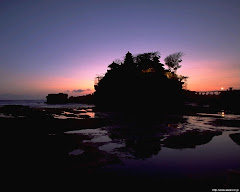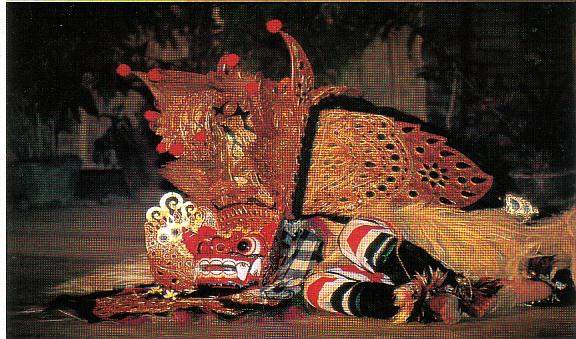Bali has around 280 species of birds, including the critically endangred Bali Starling. The only endemic mammal of the island, the Bali tiger, became extinict in the 1930s. The Bali National Park is a refuge for wildlife such as the pangolin, common, muntjac, chevrotain, leopard, cat, black giant squirrel, macaque and leaf monkey.
Thursday 22 November 2007
WILDLIFE
Posted by
NI KOMANG DIANI
at
20:41
0
comments
![]()
CULTURE
National education programs, mass media and tourism continue to change Balinese culture. Immigration from other parts of
The Hindu new year, Nyepi, is celebrated in the spring by a day of silence. On this day everyone stays at home and tourists are encouraged to remain in their hotels. On the preceding day large, colorful sculptures of ogoh-ogoh monsters are paraded and finally burned in the evening to drive away evil spirits. Other festivals throughout the year are specified by the Balinese pawukon calendrical system.
Posted by
NI KOMANG DIANI
at
20:37
0
comments
![]()
Monday 19 November 2007
LANGUANGE
Balinese and Indonesian are the most widely spoken Languanges in Bali, and like most Indonesians, the vast majority of Balinese people are bilingual or tringual. There are several indigenous Balinese languages, but most Balinese can also use the most widely spoken option: modern common Balinese. The usage of different Balinese languages was traditionally determined by the Balinese caste system and by clan membership, but this tradition is diminishing.
English is a common third language (and the primary foreign language) of many Balinese, owing to the requirements of the large tourism industry. Staff working in Bali's tourist centres are often, by necessity, multilingual to some degree, speaking as many as 8 or 9 different languages to an often surprising level of competence.
Posted by
NI KOMANG DIANI
at
20:31
1 comments
![]()
Sunday 11 November 2007
ECONOMUC INDICATORS
Economic Growth : 8.86%Income per Capita : Rp. 1,090,447.49 (1990)Exports : Garments, handicrafts, furniture, canned fish, vanilla, coffee, tuna, seaweedValue of Exports : US$ 145,997,595 (1991)Primary ProductsAgriculture - Food Crops : Rice, corn, and horticultureCommercial Crops : Coconut, clove, coffee, rubber, vanilla and fruitsLivestocks : Cows, buffaloes, sheeps, goats, pigs, horses, chickens, and ducksFishery - Fish Products : Tuna, skipjack tuna, barramundi, shrimp, seaweed, giant gouromy, and common carpFresh Water Fishery Area : 841.37 haForestry-Forest Products : Cayuput oil, rattan, and incenseProductive Forest Area : 8,535.05 haHandicrafts : The Balinese are known for the outstanding wood and stone carvingEconomics and Culture Tourism is now the leading economic activity, surpassing agriculture, the traditional source of the island’s wealth. The Balinese originally thought to confine tourism to the beaches of the south coast, but they failed to reckon with the Australians and with non-Balinese Indonesians, not to mention other nationals, who flock to the island in increasing numbers. As a result, tourism now occupies somewhat less than a third of the total land area and is creeping northward. There are 110 starred hotels. The loss of sawah (irrigated land for rice cultivation) to construction is now two percent per year. Tourism is a national preoccupation. The Balinese would do nothing to jeopardize tourism, or to harm tourists, and would resent any outside attempt to interfere with tourism. For that reason many Indonesians themselves see Bali as a retreat from the political or ethnic turmoil that they experience elsewhere. There are examples of Indonesian capital parked in Bali in small enterprises and/or vacation homes that are probably considered safer investments than elsewhere in Indonesia. Much of this development is evident in the roadside construction of small shophouses (rumoko, i.e. rumah-toko) and factories, whose activities contribute to traffic congestion and whose installations obstruct the famous views of Balinese rice terraces. Except for limitations on height, a ruling that has been in effect since the Sukarno era, there are no zoning restrictions on building. Commercial activity is not confined to the arts and crafts associated with tourism but increasingly to other activity as well. Bali has become an entrepot for multi-faceted business such as furniture manufacture, in which furniture is first made in Java, finished in Bali, then shipped out from Surabaya. Agriculture is also booming, with temporary imported labor from Java to help with the rice harvest. Bali attracts this activity because it is perceived as a nice place to live, and is seen as a place of high civilization in a beautiful rural setting. But if, because of unregulated development it is no longer a nice place to live, at what point will that development turn sour? The Balinese are beginning to wonder. Decentralization is a big unknown thus far. At the moment the provincial government is in control of the distribution of tourist revenue and taxes, 40 percent of which is distributed to the poorer kebupaten. The kebupaten boundaries are still the same as the areas of the old royal kingdoms: Dan Pasar, Klungkung, Gianyar, Ubud, etc. How this will all be affected by decentralization is not yet known. Nor is it known how decentralization will affect the intricate irrigation system. In the worst case, each kebupaten will compete without restraint to capture the most tourists and the most enterprises. In the best case, the province and the center will still enforce some moderation. The Balinese strongly support President Megawati (she is one quarter Balinese) and seem to rely on her to keep a balance. In any case, Balinese culture is holding its own against rapid development. The population is 93 percent Hindu (or the Balinese version of Hinduism which has a strong basis in spirit and ancestor worship). There is a “fierce national pride and possessiveness of Balinese culture as a national asset," Pringle said, “and a traditional intolerance toward foreigners, by which is meant Javanese.” There is also some antipathy toward non-Hindu Balinese such as Christians, who have been somewhat successful in making converts in some northern villages. It is still roughly a caste society, with about 10 percent of the population in the upper castes and 90 percent in clans associated with crafts, especially smiths (goldsmiths, blacksmiths, etc). These ancient clans go back to Majapahit times and are traditionally associated with responsibility for rituals and ritual objects. Traditional culture still has considerable importance, if some recent disputes about the high caste requirements for Balinese priesthood have any significance. Performing arts are still strong and show signs of enduring. Even transmigrant Balinese show signs of preserving their culture, as some transmigrant communities in Sulawesi have ordered Balinese gamelans to be sent to them. Pringle suggested that the strength of the culture lies in part on the energy, resilience and inventiveness of the Balinese. They are quick to take pragmatic advantage of economic opportunity, even if it means compromising the rules somewhat. Signs of the times include Balinese carvers making “genuine” traditional Asmat carving from Papua; or an instant cremation service, consisting of a pickup truck and propane gas tank, offered for families of deceased who do not have the resources for a traditional (and expensive) cremation.
Posted by
NI KOMANG DIANI
at
16:52
0
comments
![]()
RELEGION
Moslems (5.22%)Protestants (0.58%)Roman Catholics (0.47%)Hindus (93.18%)Buddhists (0.55%) .
Hinduism in
Rituals of the life cycle are also important occasions for religious expression and artistic display. Ceremonies at puberty, marriage, and, most notably, cremation at death provide opportunities for Balinese to communicate their ideas about community, status, and the afterlife. (The tourist industry has not only supported spectacular cremation ceremonies among Balinese of modest means, but also has created a greater demand for them.)
A priest is not affiliated with any temple but acts as a spiritual leader and adviser to individual families in various villages scattered over the island. These priests are consulted when ceremonies requiring holy water are conducted. On other occasions, folk healers or curers may be hired.
Posted by
NI KOMANG DIANI
at
16:51
0
comments
![]()
Thursday 8 November 2007
ADMINISTRATIVE DIVISIAONS
The province is divided into 8 regincies (kabupaten) and 1 city (kota) :
- Badung
- Bangli
- Buleleng
- Denpasar (city)
- Gianyar
- Jembrana
- Karangasem
- Klungkung
- Tabanan
DENPASAR
Denpasar is the capital city of the province of Bali,Indonesia. It is also the site of Ngurah Rai Airport, the main gateway to Bali. It has a population of 491,500 (2002). It is located at 8°39′S, 115°13′E.
Tourism
Denpasar has various attractions. The white sandy beaches are famous all over the world. Some of the famous surfing beaches are Kuta Beach, Legian Beach and Canggu Beach. Sanur beach has calmer waters and is excellent for sunbathing.Ten minutes from the Nurah Rai International Airport lies the town of Kuta. Kuta is where most of the hotels, restaurants, malls, cafes, marketplaces, and spas that cater to tourists are located. In the Denpasar area, all kinds of beautiful Balinese handicrafts are represented in local shops. These include artwork, pottery, textiles, and silver. Bali is a haven for shoppers everywhere.The famous batik cloth is sold all over Denpasar. These bright sheets of cloth are as beautiful as they are cheap. Made of pure cotton with glorious patterns, Balinese batik is definitely a good buy. Sometimes batik cloth is made into wearable clothing such as a sarong or men's shirts. The jewelry district is in a town called Celup which is 30 minutes away from Kuta. Here you will find rows and rows of silversmiths' and goldsmiths' shops selling jewelery at very low prices.
GIANYAR
Gianyar is an art and cultural town, has been well known throughout the word. Apart from proliferation of its archeological remains, in recent development, Gianyar looks so fascinating with the establishment of gardens and statues of Gods and demons along its street or at every road intersection. It is really worth seeing, because all the art works erected in this town are master pieces of Gianyar's artists, those are inspired by a single source called " Paramayoga " Hindu legend or " Purana Dewa " in mount Tengguru, that tells us about the cooperation between Gods ( Sura ) and demons ( Asura ) in their succesful effort to turn or stir fast mount Mandara, searching for elixir water or water for eternal life, which is finally ended with the change of cooperation into a war disputing the elixir ownership.
Gianyar regency constitutes an agricultural region with its beautiful nature panorama, that it's why many kinds of agricultural plantation can be developed in this region. Additionally, Gianyar Regency is rich with ancient remains and famous for high creativity of its people in field of art and culture, which considered as one of invaluable asset to the region.
With this high potential, in reality nowadays, Gianyar has grown rapidly in tourism, which is the result of the richness of the nature, traditional culture heritage as well as modern one.
Having this reality we realize there is possibility of emerging negative impacts towards the progress of Gianyar Regency globally, somehow, by understanding strong concepts of Hindu religion it is expected these impacts can be filtered, that local culture and foreign one can acculturate to each other positively and naturally.
Finally to all parties, especially those entrepreneurs are involved in tourism, we are expecting their participation to keep and develop tourism positively, that the tourism and Balinese culture which had has high value more well known and praised in the world
Last but not least, we hope this booklet will be useful for all of us.
Posted by
NI KOMANG DIANI
at
16:38
0
comments
![]()



